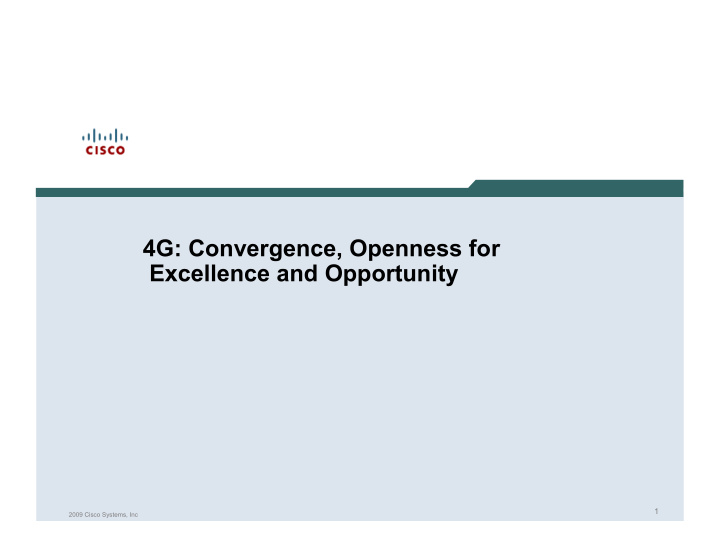



4G: Convergence, Openness for Excellence and Opportunity 1 2009 Cisco Systems, Inc
4G…Not Just for Mobility • This next generation of mobility networks will have over the air throughput speeds that will approach those of wireless /WiFi and wireline networks (+50 Mbps) • 4G has come to be a universal term describing multi-service, multi-access networks • Interest, compliance and interoperability beyond the 3G Partnership Programs and actually driven more by ETSI and TISPAN • Integrated standards efforts for mobility/wireless and wireline backhaul and transport, multi-access devices signaling across network elements for successful call admission and control, policy and QoS for transport 2 2 2 2009 Cisco Systems
4G Geopolitical Network Ideologies • 4G radio access technologies focused on improving spectral efficiencies for higher data throughput/performance • 4G networks must support multiple services including voice, video and data • Devices will contain multiple access technologies – 3G, 4G, WiFi to deliver an ever increasing set of applications 4G networks will be Converged and Open 3 3 3 2009 Cisco Systems
4G Network Vision: Open and Converged Flat Networks Applications Presence Engine And Services Real-Time Subscriber Status PSTN Service Engine PLMN Presence, Data, Routing, Service Integration Name Resolution Server Other Edge Proxy Carrier Inter-Domain Routing Access Management 3G/4G Cable/ Wi-Fi Enterprise Data DSL MTA 4 4 4 2009 Cisco Systems
Issues Being Addressed by 4G Introduction of New Applications Presence Enablement Layered atop flexible Call-Control Infrastructure Service Delivery according to Customer Situation Open interface between Call-Control and Applications Services Cognizant of Device Capabilities Fast Integration with existing services Convergence Access to Applications Access-Independent Applications Tailored to the Customer / Carrier Common service management core supporting multiple access networks Carrier controls provisioning / access Carrier, not application provider, “owns” the customer Facilitation of 3 rd -Party Arrangements Policy-Based Management of User Devices and Network Resources User-Specific, Application Specific Access Sessions, Transient Sessions, Transactions Denial: Policing, Threats, Bandwidth Limitations Facilitation: Shaping, Prioritization, Feature Requirements/Performance Based Needs 5 5 5 2009 Cisco Systems
INTERCONNECT General Target Architecture MGC MG Basic TCAP IS-41 Unified Other Subscriber Feature Feature GW Border Msging Apps Route Element Server Server DB APPS ENUM Proxy SIP, 3GPP, Record Q.1912.5 BACK END Keeping … Server Lawful Intercept Service Presence and CORE STUN/ Proxy Registration TURN Media Resource (MR) OAMP EDGE Edge CMS Proxies Other Servers QoS Policy NCS Edge Router MTA SIP Clients Cable, WiFi, WiMax, 3G 3G, Cable, WiFi, WiMax, xDSL, Ethernet, … xDSL, Ethernet, … SIP Clients 6 6 6 2009 Cisco Systems
4G Network Commonalities • Orthogonal Frequency Division Modulation (OFDM) for radio access • IP transport from the radio to the core for multiple services including voice, video, data for consumer and enterprise • Multi-service edge for support of 3G/4G RAN, WiFi, Cable/DSL • Policy/QoS necessary to maxmize user experience over varying bandwidths • Security procedures and enforcement necessary to protect network resources and as appropriate for specific enterprise and consumer requirements • Core will need to efficiently route data while providing tiered classes of service 7 7 7 2009 Cisco Systems
4G Networks: Open Access with Security Enabled Policy Manager 3 rd Party Auth Centers Partner Services Security Manager – Monitor, detect and mitigate Enterprise AAA 3 rd Party HSS Private Services IP Network Open Access Network Internet DPI, quarantine, mitigation Partner Public 3G Non-Partner 4G DSL/Cable WiFi DSL/Cable Open Devices 8 8 8 2009 Cisco Systems
Target Architecture Key Messages • Flexible, IP-enabled, services rich network foundation • Access network independent, facilitate network convergence • Focus on ease of new application and service introduction 9 9 9 2009 Cisco Systems
Target Architecture Key Capabilities • Architecture Requirements and Capabilities: Multi-Access: 3G/4G, WiFi, cable, xDSL, … Mobility and seamless service Multimedia: Voice, video, text, IM, pictures, ... Client Heterogeneity: Hard/soft, multiple media types, differing capabilities, UI, ... QoS Enabled: Leverage and control access network QoS where available, couple with service layer Multi-Application: Multi-vendor, standard interface, application composition, Unified Data Model: Single sign-on, common data model, data provisioned centrally Scalable: Multiple sites, distributed components, linear scalability through statelessness Secure: Fraud and DoS protection, user identity and privacy, anti-spam Presence-Enabled: Shared across applications, multi- source, centralized policy and control 10 10 10 2009 Cisco Systems
Summary • Increased throughput and bandwidth for mobility and IP end -to-end provide the basis for converged networks across access technologies • 4G will bring increased opportunity for uniform services regardless of device used to access • Applications will be able to take advantage of voice, video and data capabilities within a network offering greater services to consumers and enterprises • Networks will see an increase in traffic and will most likely be more distributed • Control points will be localized to manage unique services for home, office and public usage scenarios 11 11 11 2009 Cisco Systems
Recommend
More recommend